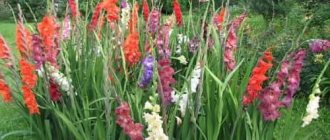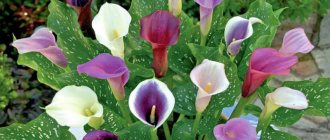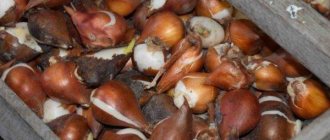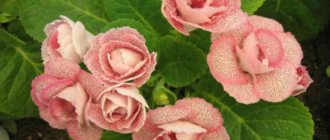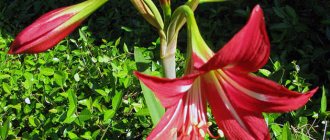Cannes are used not only in landscaping city parks, squares and alleys, but also in home gardens or vegetable gardens. These showy flowers look bright and noticeable, which is why they are becoming increasingly popular. Some are stopped by the fact that in open ground conditions the plant lives only one summer, and most often dies in freezing ground. But for those who know how to properly store the corms of this crop throughout the winter months, this is not a problem, since after one purchase of planting material, you can not only use it for many years, but also gradually propagate it. The main thing that is needed for this is knowledge of when and how to do it correctly.
You need to think about where and how to store cannas in advance. You need to familiarize yourself with all the nuances of this matter, determine whether digging in a given region is advisable, and prepare the necessary place for storage.
In what regions are they dug?
Cannas can withstand autumn cold weather, and a slight drop in temperature is not dangerous for them. If a lot of corms are left in the ground for the winter, then in the spring it will most likely be discovered that a few specimens survived the frost. But it’s not worth the risk, especially since the frost resistance of the vast majority of varieties is close to zero.
In the southern regions, where the lowest temperatures in winter do not fall below 0-5°C, these flowers are not dug up, since they overwinter well in the ground. The only preparation for winter is to lay a layer of pine needles or spruce branches on top of the beds, and agrofibre, lutrasil or spunbond is laid out on top to be sure.
In regions where frosts exceed -5°C, digging becomes a mandatory procedure, without which the crop will die.
Why doesn't canna bloom?
The reasons are different, usually it is a violation of planting dates and care features.
- If the plant planted in May was too small and had little time to grow well, then there will be no flowers this year.
- This flower from South America and Mexico needs a long growing season and plenty of warmth. If the summer is cold, flowering may not occur.
- If the rhizomes were planted in a too shady place, this will limit the development of the plants.
Preparing for digging
In order for the wintering to be successful, the flowers must be prepared in a certain way at the end of summer and beginning of autumn for the upcoming digging. The basic rules of preparation are:
- Feeding with phosphorus fertilizer during July - the first half of August. This is necessary so that phosphorus contributes to the maturation and final formation of root structures, which, in a mature state, will more easily endure the transition to the dormant period.
- Starting from the second half of September, fertilizing is completely stopped.
- At the end of summer, bushes are slightly earthed up in the tree trunk area to cover all exposed roots.
- In the second half of August, watering becomes less abundant, and the intervals between them increase. Starting in September, moistening is stopped, which is a signal for the plant to enter an inactive state.
- Vegetative parts (stems and flowers) are cut off, leaving only 10-15 cm above the ground. This must be done in dry weather, without rain or fog. The cut sites are immediately treated with a drug to combat fungi - “Mikosan-V”, “Titul-Duo”, “Copper Oxide”, “Chorus”, “Ridomil”, etc. Powder ones can be used in their pure form, sprinkled on the cut sites, and liquid diluted in an aqueous solution with the indicated dosage and sprayed onto the sections. After pruning, the flower should remain in its permanent place for another couple of weeks.
Deadlines
The main question that worries gardeners when growing cannas is when to dig to preserve the corms until spring. There is often advice to hold this event at the end of September, but you need to focus not on the calendar, but on the weather data of the current year.
The fact is that digging up tubers before a steady cold snap is observed is not rational: after a cold snap, the plant directs all the necessary nutrients into the underground bulbs, which makes it stronger and prepares it for lush flowering next season. If you dig up the roots before the completion of such natural preparation, storage and the growing season of next year will be less successful. But you shouldn’t delay digging too long either, so that frost doesn’t put the tubers under stress.
You should try to do this on the eve of the first frost. In the middle zone, this usually occurs in the second half of September - the first half of October. For northern regions, a convenient time may come as early as the second half of August, and in more southern regions, the dates may shift forward by one and a half to two months, so it is best to pay attention to the weather forecast to determine the timing. Only rhizomes of very rare and whimsical varieties are dug up earlier than required, which cannot tolerate even slight cold snaps.
Description of the plant
The canna flower belongs to the Cannaceae family and includes several dozen plant species found in the tropical regions of North America, South America, and Asia. A typical species is the Indian eland (Canna indica). In home gardens, mainly numerous, more decorative hybrids are cultivated.
Garden canna (Canna x generalis), known simply as canna, is characterized by ovate-lanceolate leaves mounted on stiff, hollow stems ending in an inflorescence. This is an extremely original perennial plant - grown for its decorative and exotic leaves and bright flowers that decorate the garden from July until the first frost.
The plant produces beautiful, very original flowers that have an asymmetrical structure and form a characteristic panicle inflorescence. Flowers are often very intensely colored:
- red,
- orange,
- pink,
- yellow.
Currently, there are unique varieties with shades of salmon or apricot, and two-tone varieties with contrasting colors are popular. The decorative effect is added by the stamens protruding from the petals.
Cannas can grow up to 2 meters, the height of the plant depends on the variety.
The canna rhizome contains a lot of starch; American tribes ate it baked.
How to dig correctly
You should start digging in dry weather. It is advisable that the ground is not wet. Make indentations on all sides of the bush at a distance of 15 cm from the stem with a shovel, trying not to damage the underground organs of the plant. The recesses are gradually enlarged, and the cut part is carefully begun to loosen. It will not be possible to dig up the rhizome without damaging the roots at all, but you need to make every effort to ensure that the bulbs do not crack or break.
It is not recommended to remove and wash away soil from the bulbs; on the contrary, it is preserved as much as possible. The remaining soil retains all the friendly bacteria and reserves of soil moisture, which help to survive the winter storage period well.
After digging the earthen clod out of the ground, it is dried for several hours in the shade. The roots should not be placed in the open sun at this time to prevent them from drying out.
Where to plant cannes in the garden: choosing a place
The most important thing you need to know about cannas is their heat-loving nature. Therefore, the most important criteria when choosing a place for planting: the area should be well lit by the sun, be warm, and the earth should warm up well. For the same reasons, it is necessary to plant in an area protected from cold winds and drafts.
Cannes prefer loose, nutritious, air- and water-permeable soil.
Shaded locations with damp, poorly heated, heavy, clay soil are absolutely not suitable for growing perennials.
If you plant cannas in the wrong place, the flower will grow slowly, be vulnerable to diseases, and flowering will be delayed. In the shade, the leaves will grow thin and elongated, and the flowers themselves will be frail and inconspicuous.
On loose, fertile soils, cannas grow best and reveal their decorative qualities and delight with lush flowering. Therefore, it is recommended to prepare the place before planting (unless, of course, this is necessary).
If the soil in the selected area is poor or not fertile enough, it is recommended to fertilize it with organic fertilizers - humus, compost. With very depleted soil - about 9 kilograms per square meter, with moderately poor soil - 5 kg per sq.m.
Winter storage
Cannas can be stored both in a dormant state and in an active form. The latter is practiced as a last resort, since the plant needs natural rest in the winter months, which serves as the key to normal growing season and active flowering next year.
In the cellar or basement
Not just any basement is suitable for storing cannas. The premises must meet the following requirements:
- the temperature must be constant, jumps below 0°C and above 7°C are not allowed;
- air humidity should be high in the range of 60-85%;
- availability of good ventilation;
- parasites, pests and mold are unacceptable;
- the storage location must be freely accessible for repeated inspections.
First of all, pay attention to the presence of mold, since it will certainly destroy the rhizomes. Before storing, it is recommended to treat the entire interior space of the basement with a solution of copper sulfate, which stops this process.
For storage, select cardboard or wooden boxes, into which tubers are placed and filled with a mixture of stone fruit sawdust, coarse sand and high-moor peat.
Caring for the rhizome consists of periodic inspections and checks of the condition of the tubers. Pay attention to the following points:
- The moisture content of the mixture inside the box. If there is insufficient moisture, you need to moisten the soil by spraying from a spray bottle. The main thing is not to overdo it.
- When areas of rot appear, they need to be cut off with a sharp knife to healthy tissue, and carefully sprinkled with crushed charcoal on top.
Home storage
At home, cannas can be stored both in a dormant state and in an active form.
In a cool place
Before such wintering, not the entire ground part is removed, but only the flowering shoots.
In this case, the following content parameters must be observed:
- good lighting;
- air temperature up to 13°C;
- watering once a month (without waterlogging).
Such conditions in a house or apartment can be on an unheated loggia or closed balcony, on a veranda or in a corridor without radiators. If individual leaves begin to turn yellow, they should be cut off.
Before the end of winter storage, it is advisable to gradually increase the temperature, water more often, and a couple of weeks before planting in the garden, feed the plant with a nitrogen complex.
Like a houseplant
You can overwinter cannas as an indoor flower, but it is convenient to do this only with low-growing varieties that do not take up much space. If the home is spacious, then tall varieties are preserved using the same method until spring.
In this case, there is no need to cut off the ground parts before digging; the flower stalks are left on the bushes. You can transplant them into containers or individual pots in advance, so that before bringing them into the house they have time to adapt to the new container. Boxes or pots should be spacious - this is the main condition for good health with this method of wintering. The soil is a mixture of high-moor peat, vermiculite and sawdust, taken in equal volumes.
After bringing the plants into the house, it is best to place them next to a window where there will be a sufficient level of illumination. All wilted flowers are cut off immediately so that they do not spoil the appearance and do not deprive the plant of the energy needed to ripen the seeds. In order for flowering to continue as long as possible, periodic watering with phosphorus-potassium mineral complexes is needed, which is carried out once every two weeks.
The formation of buds and flowering can continue until the end of December, and, subject to low temperatures (15-17°C), until the end of January. After this, the foliage begins to turn yellow and dry out, and then falls off. The dormant period will last about a month until new leaves appear, after which fertilizing with a weak solution of nitrogen fertilizers for decorative deciduous crops should begin.
In a refrigerator
This option is most often used for winter storage of low-growing varieties, since it requires sufficient space in the refrigerator. Such storage is also suitable for planting material that is purchased in winter.
The preparation of bulbs with this method differs from the standard procedure. After digging, the roots are washed with running water to clear them of soil. Then antifungal treatment is carried out, which consists of daily soaking of the washed tubers in a weak solution of potassium permanganate or any specialized fungicidal agent.
After a day, they are laid out on newsprint and allowed to dry. After this, each rhizome is wrapped in dry newspapers and placed in plastic containers to be placed in the refrigerator. The containers are not sealed with airtight lids to allow free access of air to the roots. Storage is allowed not in newspaper sheets, but in a layer of sand or sawdust. You should not stack the bulbs densely, since crowded spaces contribute to poor air circulation and the spread of lesions.
Caring for such planting material consists of periodic inspection and ventilation, which is carried out once a week. Any parts that raise doubts about absolute health are removed. When the tubers dry out, lightly spray them with water from a spray bottle, but this should be done very rarely - no more than once a month.
In the first half of April, cannas are taken out of the refrigerator and immediately planted in the ground in pots or planting boxes. After the seedlings appear, young plants begin to be fertilized using a complete mineral complex. Until warm weather sets in, the flowers are kept indoors and then planted in open ground.
Of all the existing storage methods, you can choose the most suitable one, based on the existing conditions or space in the basement and refrigerator. Normal maintenance during the winter season guarantees good vegetation and spectacular flowering, which can be observed in the garden as a reward for the time and effort spent.
Features of growing cannas
Despite the fact that cannas are an exotic plant, they are unpretentious to grow. The main thing is to follow some growing rules.
- In February, seeds are planted for seedlings. If planting is done with tubers, then in May. Some gardeners prefer to pre-germinate the tubers. Then you can plant them in March.
- Planting is carried out in well-drained and nutritious soil. The landing site should be well lit.
- Plants need regular watering. Cannes need to be watered especially generously during the flowering period. And they begin to bloom in July.
- Mineral fertilizers need to be added to the soil two or three times a season.
- It is necessary to ensure that the plants do not get sick and are not damaged by pests (aphids, spider mites).
- When growing exotic flowers, you need to immediately think about how to store canna bulbs in winter.
